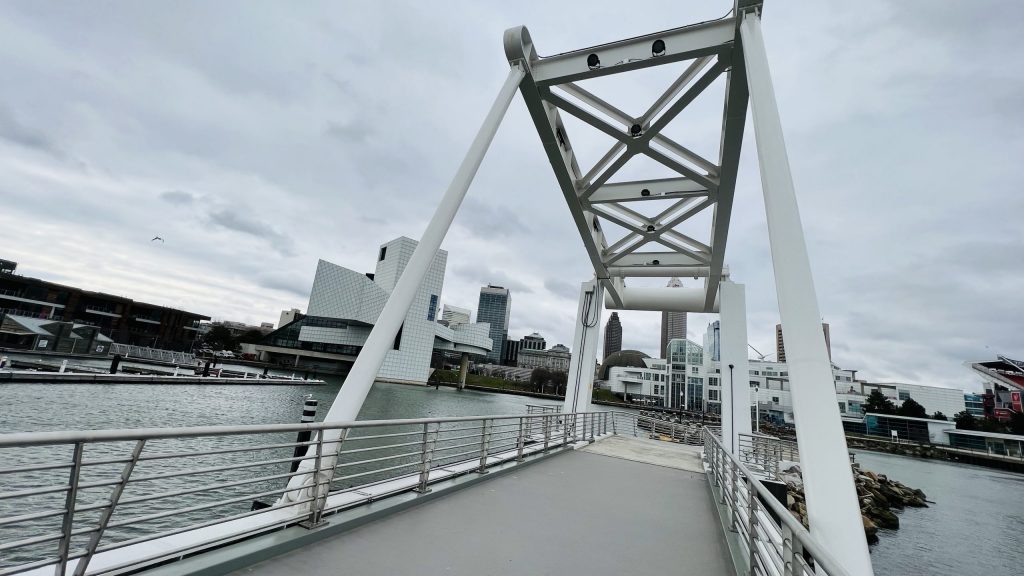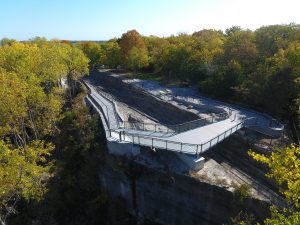

A Tale of Two Bridges
Two iconic Ohio landmarks – Cleveland’s North Coast Harbor and Kelleys Island’s Glacial Grooves Geological Preserve – recently installed pedestrian bridges featuring GFRP decks.
The North Coast Harbor is situated amid multiple local attractions, with the Rock & Roll Hall of Fame to the south, the Great Lakes Science Center to the west and Voinovich Bicentennial Park to the east. The new bridge spans the harbor, allowing visitors to easily cross between attractions. It’s also a working drawbridge to provide boats access to the harbor’s marina.
Scott Reeve, director of business development for Creative Composites Group (CCG), the deck’s manufacturer, says that at 10 pounds per square foot, composite materials are an obvious choice for moving bridges.
“FRP decking makes a lot of sense because it is so lightweight,” he says. “The heavier the structure, the larger and more complicated the machinery is [to move it] and more expensive. That’s why FRP is a great solution.”
The deck was constructed with two 51 x 13.67-foot panels with interlocking ends that overlap to create a smooth path when the bridge is down. The panels were laid up by hand with a single layer of unidirectional and triaxial (+/-45/90) glass fiber fabric on either side of a fiber-reinforced foam core, then vacuum infused with a vinyl ester resin. Once cured, the panels were finished with a non-skid surface from Matacryl.
The panels include a slight cross slope for water drainage and 6-inch deep, 14-foot-long curved drains covered with GFRP grating post-production. Forty stainless steel bolt receptors were embedded in each panel to affix it to the bridge’s steel girders and railings.
“Typically, we might have considered breaking this [the deck] into four pieces. But since it was a movable bridge, we liked having fewer joints,” says Reeve. “In any structure – whether it is steel or concrete or FRP – if a problem is going to happen, it is more likely to happen at the joints.”
The second bridge is 85 miles west of North Coast Harbor on Kelleys Island, the largest U.S. island in Lake Erie and home to one of the world’s largest exposed glacial grooves sites, the Glacial Grooves Geological Preserve. Commissioned by the Ohio Department of Natural Resources (ODNR), the pedestrian bridge replaces an ailing steel walkway that was installed decades ago to protect the grooves from foot traffic. The GFRP bridge resembles an inverted “v” to give the preserve’s estimated 100,000 annual visitors good views of the 400-foot-long, 30-foot-wide grooves that the icy glacier scoured into limestone 18,000 years ago.
Coastline Composites, a consulting firm that assisted ODNR with the project, initially recommended large, molded FRP panels. However, after considering the challenges of delivering large parts to a wooded site on an island accessible only by boat or plane, the company chose CCG’s smaller prefabricated planks instead.
“We weren't going to get huge panels delivered out to Kelleys Island easily,” says Gregg Blaszak, P.E., president of Coastline Composites. Another benefit of the smaller planks was that the contractor could cut them in the field to fit the unusual geometry of the bridge.
The deck was built with CCG’s 54 H-5 SuperDeck® Lite GFRP profiles measuring 1-foot wide and between 13 and 16.5 feet long. They were pultruded in a single day using continuous roving, a continuous filament mat and a polyester resin and were finished with a Matacryl non-skid surface. The engineered fabrics provide the shear strength needed to meet LRFD Guide Specifications for Design of Pedestrian Bridges and accommodate H-5 maintenance vehicles (10,000 pounds).
The general contractor, The Ruhlin Company, assembled the deck onsite. The construction team fastened the undersides of the composite profiles to the bridge’s steel structure using CCG’s stainless steel clamping system, which eliminates the need for drill holes and fasteners on the deck and creates a smooth, aesthetically pleasing surface.
Both bridges have an expected lifespan of 75 years.
“We've had complaints that people have used high-end, treated lumber decks and they failed within 10 years,” says Reeve. “People want sustainability. They want to be able to put it in and forget about it.” GFRP bridge decks are designed to deliver.
Melissa O’Leary is a freelance writer in Cleveland and a frequent visitor to North Coast Harbor and Kelleys Island. Email comments to melissa@good4you.org.

The North Coast Harbor pedestrian bridge showcases the benefits of lightweight GFRP decks, as well as their aesthetic appeal.
Photo Credit: Creative Composites Group

Made from 54 pultruded GFRP deck profiles, a pedestrian bridge on Kelleys Island in Lake Erie allows visitors a close-up view of the 400-foot-long, 30-foot wide, 10-foot deep Glacial Grooves Geological Preserve.
Photo Credit: Jay Harris, Creative Composites Group

SUBSCRIBE TO CM MAGAZINE
Composites Manufacturing Magazine is the official publication of the American Composites Manufacturers Association. Subscribe to get a free annual subscription to Composites Manufacturing Magazine and receive composites industry insights you can’t get anywhere else.



